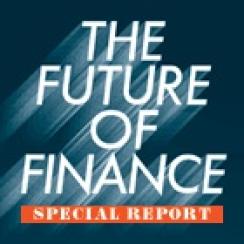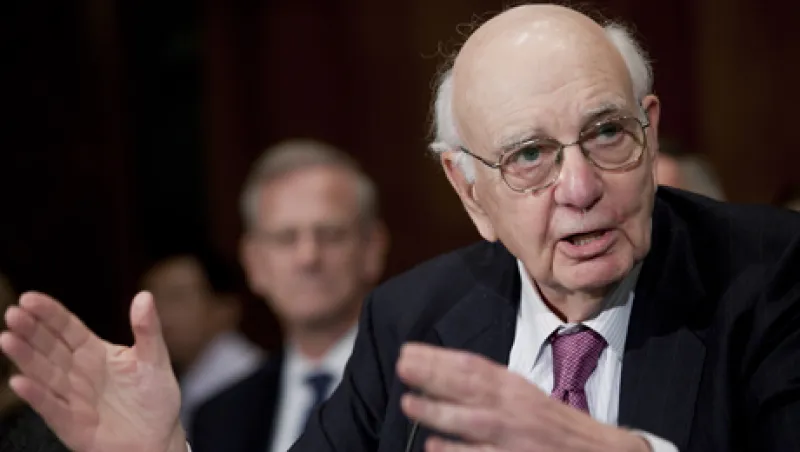
Volcker was taking critical shots mainly at financial product engineering and the over-dependence on quantitative models and complex derivatives that trumped traditionally prudent banking practices during the last boom and contributed to the global economic meltdown of 2008-’09. As Columbia University economist and Nobel laureate Joseph Stiglitz has put it, “Many of the so-called innovations were not wealth-enhancing. They were privately profitable” to the institutions creating them, “but socially disastrous.” Financial engineering, however, is hardly the only form that financial innovation takes. Industry executives are talking about and investing in innovation far more broadly, taking advantage of accelerating price-performance improvements in information technology. The biggest banks are allocating hundreds of millions, if not billions, of dollars from their IT budgets — or from the savings derived from adopting cheaper and faster systems — into product development and service enhancement in core wholesale and retail businesses.
If this is indeed the cusp of a new and different wave of technology-driven innovation in financial services, it would not be the first.
Citibank and ATMs
The first wave of computer-age financial innovation may be symbolized by the ATM to which Volcker referred, but there is far more to the story. It is traceable to one particularly boundary-breaking institution, Citibank, and to John Reed, who joined the bank out of Massachusetts Institute of Technology in the mid-1960s. He would succeed the man who hired him, Walter Wriston, as chairman, from 1984 to 2000, but not before bringing back-office operations up to automation and efficiency standards comparable to those in the manufacturing sector. That particular bit of reengineering alone was groundbreaking for a service company, especially considering the immense scale of a New York money center bank, owing to the fresh thinking of Reed (M.S. in management from MIT’s Sloan School, 1965) and others from nontraditional backgrounds who followed him into the bank.
Today’s ubiquitous networks of commoditized ATMs are one of Reed’s legacies as Citi’s retail banking chief in the 1970s and 1980s. (Neither Reed nor any other banker actually invented ATMs, the earliest versions of which were produced by U.K. banknote printer De La Rue and defunct Dallas-based manufacturer Docutel Corp. Engineers from those two companies, John Shepherd-Barron of De La Rue and Donald Wetzel of Docutel, owned the patents.)
Before Reed came along, the machines were clunky and relatively scarce, not even at every bank branch, and what ensued was a classic case of applied, game-changing innovation.
Citi’s plan was to deploy ATMs on a scale that no other bank had then been contemplating — installing at least two at each of the bank’s hundreds of branch offices and reconfiguring the branches so that the ATMs were placed indoors and close to the conventional teller windows. Customers could therefore view the machines as alternatives to human tellers during banking hours, and as fully functional surrogates at off hours.
The “off-the-shelf” ATMs available from manufacturers did not meet Citi’s specifications. Instead, the bank’s Santa Monica, California, development subsidiary, Transaction Technology, wrote custom specifications and had the machines assembled under contract — with screen interface and card-reading features that were a hit with customers and that competitors took years to catch up to.
Citi became such an outlier, Reed says in an interview, because it was a time of “optimism in the world” and shared purpose in “building businesses” without as much regard to short-term earnings targets as there is today. But also, his predecessor, Wriston, “reached for the future” and actively cultivated new and innovative ideas, preferring to recruit people who were “smart and full of energy,” regardless of academic background.
In 1967 Wriston commissioned TEMPO, a consulting arm of General Electric Co., to produce a set of studies on how the financial industry would look in 2000. “One of the books was on the impact of computers in banking, and Walt gave it to me to figure out,” Reed recalls. “He had just taken over as CEO and asked a consulting firm to look 33 years into the future. That was innovative thinking.”
That ethos prevailed throughout Reed’s tenure as chairman, which ended after what was then Citicorp merged with Travelers Group in 1998, and Reed gave way to Sanford Weill. The cross-industry combination required repeal of the Glass-Steagall Act to be formally and permanently permissible — a legislative step the following year that both Reed and Weill now say they regret — but even that bout of lobbying was not out of character for Citi. Under Wriston, the bank continually pushed against regulatory limits and often succeeded, gaining powers that accelerated its interstate and international expansion and allowed the parent holding company to diversify into venture capital and other nonbank realms.
Internet Finance
Following the merger, Reed retired — he is currently chairman of the MIT Corporation — and many of the people responsible for the old mojo departed. The advent of the Internet lowered the proverbial barriers to entry, and online banking and brokerage — fields in which Citi had experimented even in the early days of DOS computers and dial-up connections — rapidly went mainstream.
The dot-com-fueled wave of innovation was not dominated by any one institution. Deutsche Bank (and Bankers Trust Co. before their 1999 merger), Goldman Sachs Group, J.P. Morgan & Co. (along with 2000 merger partner Chase Manhattan Corp.) and Morgan Stanley raised their profiles as developers and financers of web-enabled businesses. Wall Street firms invested in a plethora of electronic trading systems and platforms. At the turn of the century there were well over 100 of them in fixed-income markets alone — a bubble that had to burst.
“People were investing in a new world, and there was a lot of energy,” recalls Richard McVey, chairman and CEO of New York–based MarketAxess Holdings, which survived the bond-platform shakeout, went public in 2004 and today has a market capitalization exceeding $1 billion. “Others were worried about technology being disruptive to their business — something that is still happening today.”
MarketAxess was created within J.P. Morgan’s LabMorgan, which in 1999 took over the 46th floor of the headquarters building. “The idea was to use technology to extend our reach,” says Nicolas Rohatyn, who headed the unit and currently runs the New York–based investment firm Rohatyn Group. “People were just starting to get a sense of how the technology could change the business.”
Another LabMorgan launch, currency trading platform FX Alliance, went public in February and was acquired by Thomson Reuters in August for $625 million. As with McVey at MarketAxess, FX Alliance’s CEO, Philip Weisberg, came out of the Morgan bank and has been in charge since inception.
“Those are major accomplishments. They created a lot of jobs and a lot of wealth,” says Rohatyn who puts in the same category an earlier J.P. Morgan spin-off that was not part of LabMorgan but helped blaze the trail: risk management systems company RiskMetrics Group, which raised $245 million in its 2008 IPO and was acquired in 2010 by MSCI for $1.5 billion.






